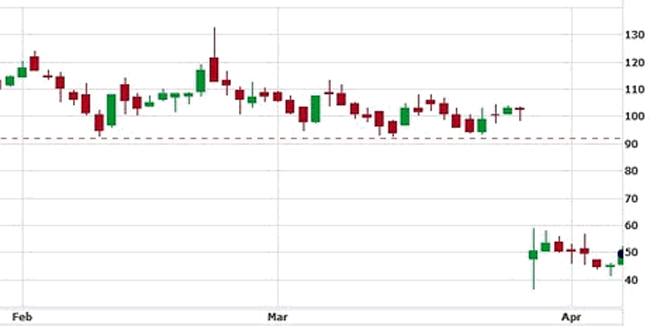Protecting Against Price Gaps
Oct 24, 2011 at 8:07 am in Risk Management by
A price gap occurs when the price of a financial instrument falls (or rises) far and fast, moving apparently from one price level to another with no opportunity to trade at prices in between; more importantly, with no opportunity to stop out at a price in between. If you don’t know what a price gap looks like, here’s one for you to see:

For the purposes of this article it doesn’t matter which stock this was, or when exactly the price gap occurred. What it important is that your stop order placed appropriately at the 91p price level would likely not have executed at this price. The best you could have hoped for would have been to stop out at much lower 60p.
While you can’t predict price gaps (else they would not occur at all) you can take some steps to mitigate their consequences. Here are some ideas:
Day Trading
Days traders make a point of closing all open positions at the end of the trading day, thereby not exposing themselves to price gaps that are most likely to occur on adverse news overnight or over the weekend. It’s a fine solution, but is not appropriate for a longer-term position trader like me.
Guaranteed Stop Orders
The best protection against price gaps is to use a guaranteed stop order, but these come at a cost. Since I like to apply a tight stop order initially, the greater minimum stop distances mandated by guaranteed stop orders are particularly problematic for me, but I might consider guaranteeing a stop order on a position that is in profit and on which I would apply a wider profit-locking stop order in any case.
As an aside, it may be possible notionally “to profit from a price gap” using a guaranteed stop order. The spread betting platform is obliged to stop you out at your specified price, and you
may be able to re-purchase immediately at the lower gapped-down price in anticipation of the gap closing.
Diversification
An adverse price gap will hit you hardest if you bet the farm on a single unfortunate stock. I prefer to diversify my spread bet holdings so that no one price gap can wipe me out. While my separate holdings may well fall together, in orderly fashion, and will therefore stop-out in orderly fashion, it is most unlikely that they will all gap-down together.
Position Sizing
Holding multiple stock positions is only part of the diversification story, and it won’t really help you if choose to bet £1-per-point on a 1000p-per-share stock plus £1-per-point on ten different 10p-per-share stocks. In this case, you’ve still effectively bet the farm on the higher priced stock. So think about spreading your risk more equally across you diverse spread bet portfolio.
The Good News About Gaps
So there you have it, a few suggestions for mitigating the adverse effects of price gaps. But it’s not all bad news.
While price gaps are bad news for existing holders of a stock, they may in fact present an opportunity for non-holders to buy in at a more much favourable price than their unfortunate counterparts. In my original chart example, post-gap buyers could buy stock at up to 50% discount. Nice!
Tony Loton is a private trader, and author of the book “Stop Orders” published by Harriman House.

